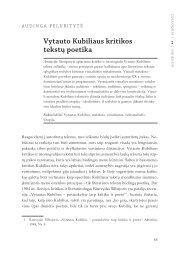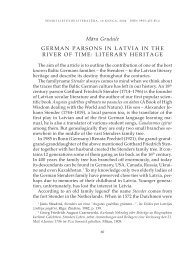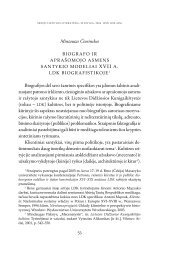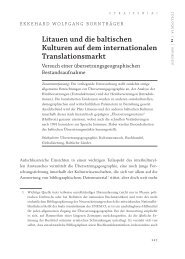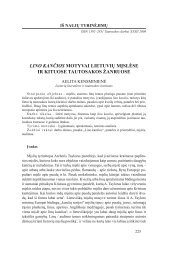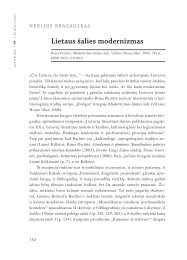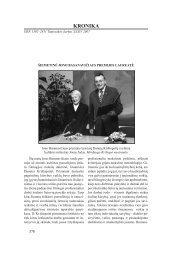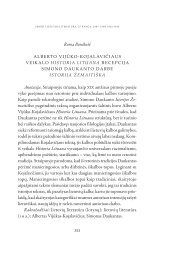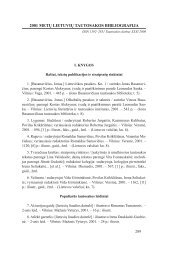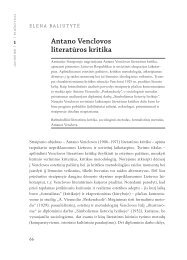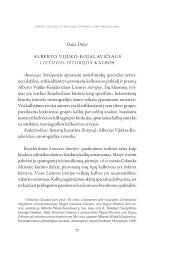CONCEPTS OF THE NATIONAL IN RUSSIAN ETHNOORGANOLOGY
CONCEPTS OF THE NATIONAL IN RUSSIAN ETHNOORGANOLOGY
CONCEPTS OF THE NATIONAL IN RUSSIAN ETHNOORGANOLOGY
Create successful ePaper yourself
Turn your PDF publications into a flip-book with our unique Google optimized e-Paper software.
In a rather polemical contribution “Russian Folk Instruments and the Orchestra<br />
of Russian Folk Instruments” Matsievsky’s student Iurii Boiko (1984) compared and<br />
contrasted oral tradition to orchestral formations for representative and educational<br />
purpose of the Soviet state. Thus Boiko emphasizes the social dimension of folk<br />
music concept. His analysis shows a parallel existence of completely different and<br />
independent ways of music making within one national culture. On the contrary,<br />
Mikhail Imkhanitsky claims a historical continuity in “Russian folk orchestra<br />
culture”. According to Imkhanitsky the “first Russian orchestra with national<br />
instrumentation was conditioned by the whole history of instrumental art of<br />
Russia’s past centuries, especially of ensemble art” (1987: 5, 45). In this highly<br />
deterministic view, the medieval skomorokhi appear as agents of a “prehistory”<br />
of the “folk orchestra”, created at the end of the 19th ct. Some scattered sources,<br />
however, can hardly confirm a “predominantly collective character of folk music<br />
performance” (1987: 7) by the old Slavs. The ethnographic sources from the last 250<br />
years speak more for a characteristic solo or duet performance. Ensemble playing<br />
is restricted to few local traditions and less typical for Russian folk music – in<br />
contrary to other eastern European styles.<br />
The concept of national continuity clearly appears in the first monograph<br />
on Russian traditional instrumental music published in Russian. The Moscow<br />
folklorist Aleksandr Banin remarks that, “all three components of instrumental<br />
art [the contemporary oral tradition, the Russian art music, the ‘folk orchestra’]<br />
are, in our opinion, successors of the prepetrinic Rus’ having equal rights” (Banin<br />
1997: 12). The argumentation of this bold statement in a sense of a “holistic system<br />
of Russian instrumental tradition” (1997: 174) is however a rather confounded<br />
undertaking.<br />
Banin suggests an influence of the skomorokhi on westernised art music in the<br />
late 17th ct.: “The descendants of the skomorokhi of the 17th ct. partly disolved in<br />
folklore environment, and partly flew into the developing art of written tradition.<br />
In fact, with whom one could put together the first actor’s troupes, with whom the<br />
first orchestras of written tradition (together with foreign musicians and actors) if<br />
not with skomorokhi?” (1997: 11). At least in the 18th ct., when most orchestras<br />
were founded, many of them consisted of bondmen. About skomorokhi – or their<br />
mysterious “descendants” – as orchestra musicians we have no evidence. Probably<br />
no Italian, German or Russian master of the chapel of this time would allow in his<br />
orchestra any features of performing style or even repertory connected with the<br />
skomorokhi, whose art was categorically forbidden after 1648.<br />
Further, Banin claims that “forms of existence of this [the peasant’s] tradition<br />
documented from contemporary bearers at least within the last two hundred years<br />
were not affected by any substantial changes” (1997: 11). According to this point of<br />
view, neither the development of the balalaika from a two-string drone instrument<br />
to a three-string one with a predominant chordal style, nor the total extinction of<br />
all pure drone instruments (fiddle, bagpipe, further hurdy-gurdy), the triumphant<br />
advance of the harmonica, the adoption of common European aristocratic dances<br />
151



